Summary
One of the most famous wooden bridges
A national site of scenic beauty, the Kintaikyo Bridge is one of the most famous wooden bridges in Japan.
In 1673, the lord of the Iwakuni Domain, Hiroyoshi Kikkawa built a wooden bridge, which was to serve as the prototype for the bridge that exists today. Unfortunately, this bridge was soon washed away.
The following year, the bridge was reconstructed with improvements. This bridge retained its majestic appearance for 276 years, until it was carried away by Typhoon Kezia in September 1950. After it was destroyed, the bridge was rebuilt again as a timber bridge, at the strong request of the local residents. From Heisei 13 (2002), the weakened wooden parts were replaced during a project known as the Heisei Era renovation and were newly constructed from Japanese cypress in March 2004.
Performed by successive generations of bridge engineers in the same way it was performed on the original bridge, replacement of the wooden bridge sections is a traditional undertaking which has remained largely unchanged since the Edo period.
The bridge has a surface length of 210 m and a total length of 193.3 m. It is 5 m wide and the piers are 6.6 m tall.
It was constructed using a timberwork technique that employs metal belts and nails.
The unique, sophisticated construction of the bridge arches is said to be impeccable, even from the perspective of modern bridge engineering.
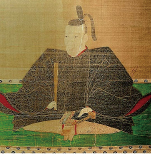 |
 |
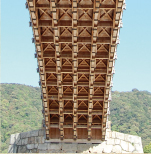 |
| Hiroyoshi Kikkawa | Alternative bridge installed during the first phase of the project |
A timberwork technique |
Landscape around the Bridge
Kintaikyo continues to fascinate visitors with its exceptional beauty, which changes according to the time of the day and the season of the year.
On and around the Kintaikyo Bridge, several events are held annually. April 29 each year marks the date of the Kintaikyo Festival, designed to demonstrate residents’ gratitude for their ancestors who built the Bridge. Every first Saturday in August, the Nishiki River Water Festival is held. From June 1 to August 31, cormorant fishing, which originated during the Edo Period, is observed in the traditional style.
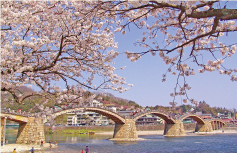 |
 |
| Kintaikyo in spring | Kintaikyo Festival |
 |
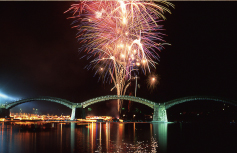 |
| Cormorant fishing, conducted below the Bridge |
The Nishiki River Water Festival |
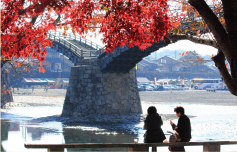 |
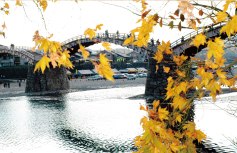 |
| Kintaikyo in autumn | Kintaikyo in autumn |
 |
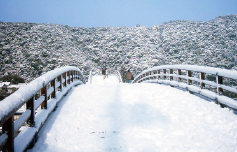 |
| Kintaikyo in winter | Kintaikyo in winter |
Entering Kintaikyo Bridge
■Kintaikyo Bridge entrance ticket
| Adults (Junior high school students and older) |
|---|
| 310yen per person 260yen per person of group |
| Elementary school students |
|---|
| 150yen per child 120yen per person of group(Infants and small children:free) |
*One-way fares are not available.
*For group rates, a group needs to be comprised of 15 people or more.
*Kintaikyo Bridge entr
■Set ticket
Includes the Kintaikyo Bridge, the ropeway, and Iwakuni Castle
Time required-approximately 1 hr. 30 mins.-2 hrs.
| Discount (from April 1st, 2014): |
|---|
| Adults:1,140yen→970yen per person (groups:760yen) |
| Discount:Elementary school students: |
|---|
| 530yen→460yen per child (groups:350yen) |
Other discounts are given for people with a physical disability passbook, etc.
*Precaution
The bridge is accessible from both the town side and the mountain side.
Please be careful of the steps on the bridge.
Please be aware that the bridge can become slippery in rainy or snow days.
No reservation is necessary to visit the Kintaikyo Bridge.
Littering and smoking in the street is not permitted on Kintaikyo or in the surrounding area.
The bridge may be closed when the Nishiki River is at high water or during heavy rains or strong winds.
■Opening hours/08:00 a.m. - 05:00 p.m.
*During tourist season: until 06:00 p.m.
*Extended summer hours: until 07:00 p.m.
*The nighttime illuminations are lit until 10:00 p.m.
*The Bridge can be accessed 24 hours a day, but the illuminations are switched off at 10:00 p.m At times when the cashier booths are unattended, please deposit the fee into the nighttime farebox provided.
■For more information
Please contact Nishikigawa Tetsudo Co. Ltd, Iwakuni Office
Call +81-827-41-1477
